UNRULY PASSENGER INCIDENTS ON THE RISE? Enforceable regulations and fresh guidance must halt the rise in unruly passenger incidents CEO Interviews Cathay Group, American Airlines | Safety IATA Safety Issue Hub | Timatic Automation key to help congestion Data Net Zero Roadmaps | Noise Balanced Approach to aircraft noise airlines.iata.org 2023 –03
tt &Whiti itt dtti th SMARTER. CLEANER. GREENER.























Pratt & Whitney is committed to supporting the commercial aviation industry achieve net zero carbon emissions by 2050. Getting there will take big ideas, expertise, experience and hard work, qualities at the core of who we are. To reach net zero we go beyond – working smarter, cleaner, greener today for a more sustainable tomorrow.
LEARN MORE AT PRATTWHITNEY.COM/SUSTAINABILITY















 P
P
Comment
5 Willie Walsh, Director General

The contagion of European passenger rights for delays and cancellation
Digest
10 IATA and industry update
IATA calls for Sri Lankan aviation blueprint, Improving safety in Africa, Aviation accident reports
12 Data: In numbers


Net zero roadmap
CEO Interviews
14 Positive positioning
Cathay Group Chair Patrick Healy says Hong Kong is well positioned to resume its status as a world-class aviation hub
22 Reliability and return to profitability

Robert Isom, CEO of American Airlines says the carrier’s solid performance is the bedrock for an array of improvements

IATA Corporate Communications

Vice President Anthony Concil
Creative Direction Richard McCausland
Assistant Director Chris Goater www.iata.org
Editorial
Editor Graham Newton
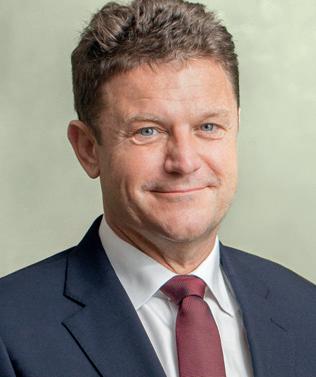
Head of content production DeeDee Doke
Production editors Patrick Appleton, Vanessa Townsend
Senior designer Gary Hill
Picture editor Jessica Marsh
Production
Production manager Jane Easterman +44 (0)20 7880 6248 jane.easterman@redactive.co.uk
Publishing director Aaron Nicholls
Advertising Business development manager +44 (0)20 7324 2763 airlines@redactive.co.uk Follow
Features
18 Safety challenges
As an internationally recognized risk register, the revamped IATA Safety Issue Hub promises further safety benefits

28 Timatic

Automating and accelerating passenger processing times are essential to meeting air travel demand
35 Cabin safety
How can airlines reduce the rise in the disruptive behavior of some unruly passengers?
40 Noise mitigation
Noise remains a significant challenge for the industry, with a Balanced Approach by governments needed

Airlines. ISSN 1360-6387


The opinions expressed in this publication are those of the individual authors or advertisers and do not necessarily reflect those of Redactive, IATA or its members. The mention of specific companies or products in articles or advertisements contained herein does not imply that they are endorsed or recommended by IATA or Redactive.
The paper in this magazine is elemental chlorine free (ECF), manufactured within ISO 4001 environmental management standards and is sourced from sustainable managed forests. All of this publication’s content is subject to copyright, design rights and trademarks of Airlines. and third parties.

1428 35 3 2023 – 03 Airlines airlines.iata.org Airlines. Contents 2023 – 03 Recycle your magazine’s plastic wrap – check your local LDPE facilities to find out how. Subscribe to the Airlines. fortnightly email - register your details at www.iata.org/optin Published by Redactive Media Group, 9 Dallington Street, London, EC1V 0LN www.redactive.co.uk To access Airlines. content online visit www.airlines.iata.org For Airlines. subscription
change of address notifications, email Airlinesint@iata.org We welcome feedback and content ideas
requests, or
IATA on Twitter
and join our LinkedIn group
@IATA
Flight delays happen.
How you respond is what sets you apart.

When your passengers experience a disruption, they need to be reticketed. Fast. TA Connections can help you get that passenger reticketed and One airline expects to save over £10M with TA Disruption Hub and Intelligent Ticketing Switch. They also improved customer service at their service teams’ resolution times.




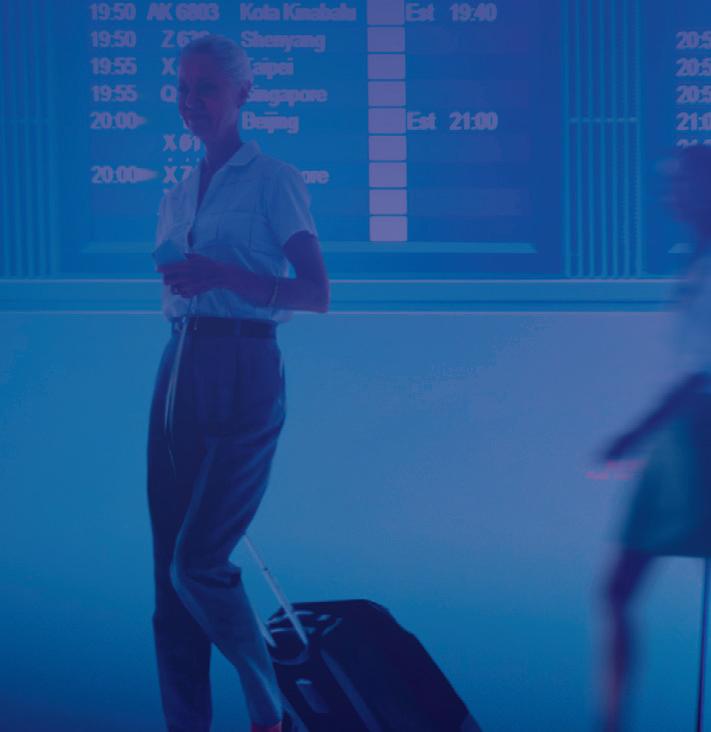



Can you realize these same cost savings?

Solutions that transform airline operations | taconnections.com
European passenger rights contagion
“It should come as no surprise that, nearly two decades after EU261 came to be, consumers are paying more to cover the cost of compensation, and EU studies show no improvement in delays or cancellations. The recent failure of air traffic control in the UK is yet another example of why the passenger rights system isn’t fit for purpose. Airlines will bear significant sums in care and assistance charges, on top of the costs of disruption to crew and aircraft schedules. But it will cost NATS nothing. The UK’s policy makers should take note. The passenger rights system needs to be rebalanced to be fair for all with effective incentives.
“EU 261 will be the model for the United States’ punitive passenger rights regime. And Canada’s latest innovation on its 261-style regime makes the airline guilty until proven innocent. Considering that 93% of Canadian travelers polled told us that they were satisfied with their last flight, this is a regulatory sledgehammer to crack a nut, and the results will be messy. We must keep careful watch because governments from Australia to Latin America and the Middle East are all thinking about their own innovations in this area, which could be a nightmare for airlines and their passengers.”
On North American ATM shortcomings:
“Ottawa and Washington, DC need to take ownership of the issues under their direct control and lead in resolving them. Appointing a permanent FAA Administrator would be a first and major step in urgently addressing the US aviation/air traffic control infrastructure constraints, which are hindering airlines from delivering the service travelers expect.”
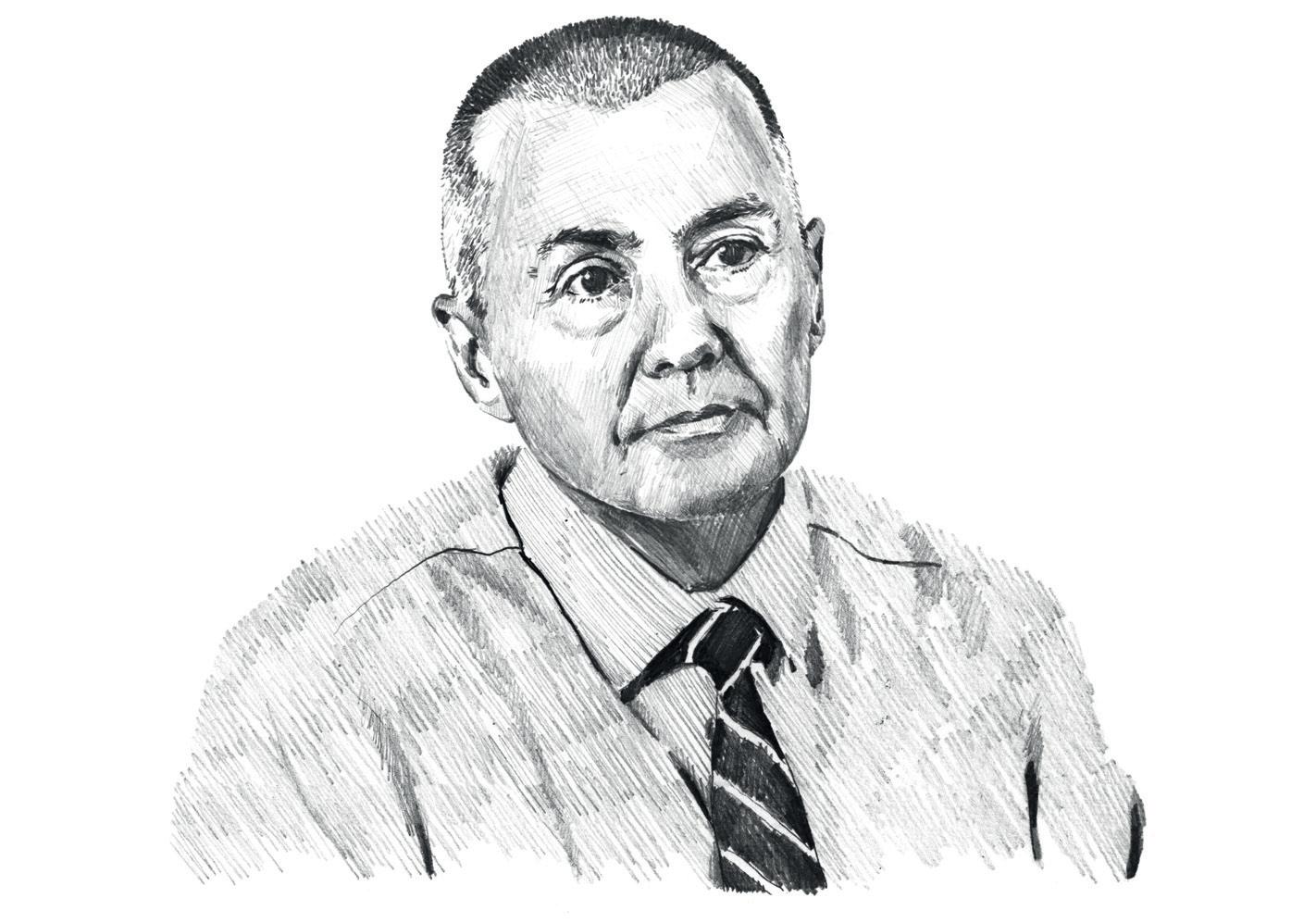
On $95 million of blocked funds in Ethiopia:
“This sends all the wrong signals and puts at risk the economic and social benefits that its global hub supports Ethiopia’s development with. Ethiopia must follow the global rules that it benefits from. It’s time for the government to work with industry to resolve this situation quickly.”
On European summer demand:
Willie Walsh IATA Director General
“As strong as travel demand has been, arguably it could be even stronger. Demand is outrunning capacity growth. Well documented problems in the aviation supply chain mean that many airlines have not taken delivery of all the new, more environmentally friendly aircraft they had expected, while numerous aircraft are parked awaiting critical spare parts. And, for the fleet that is in service, some air navigation service providers (ANSPs) are failing to deliver the requisite capacity and resilience to meet travel demand.”
5 2023 – 03 Airlines airlines.iata.org
Willie Walsh: DG Insight
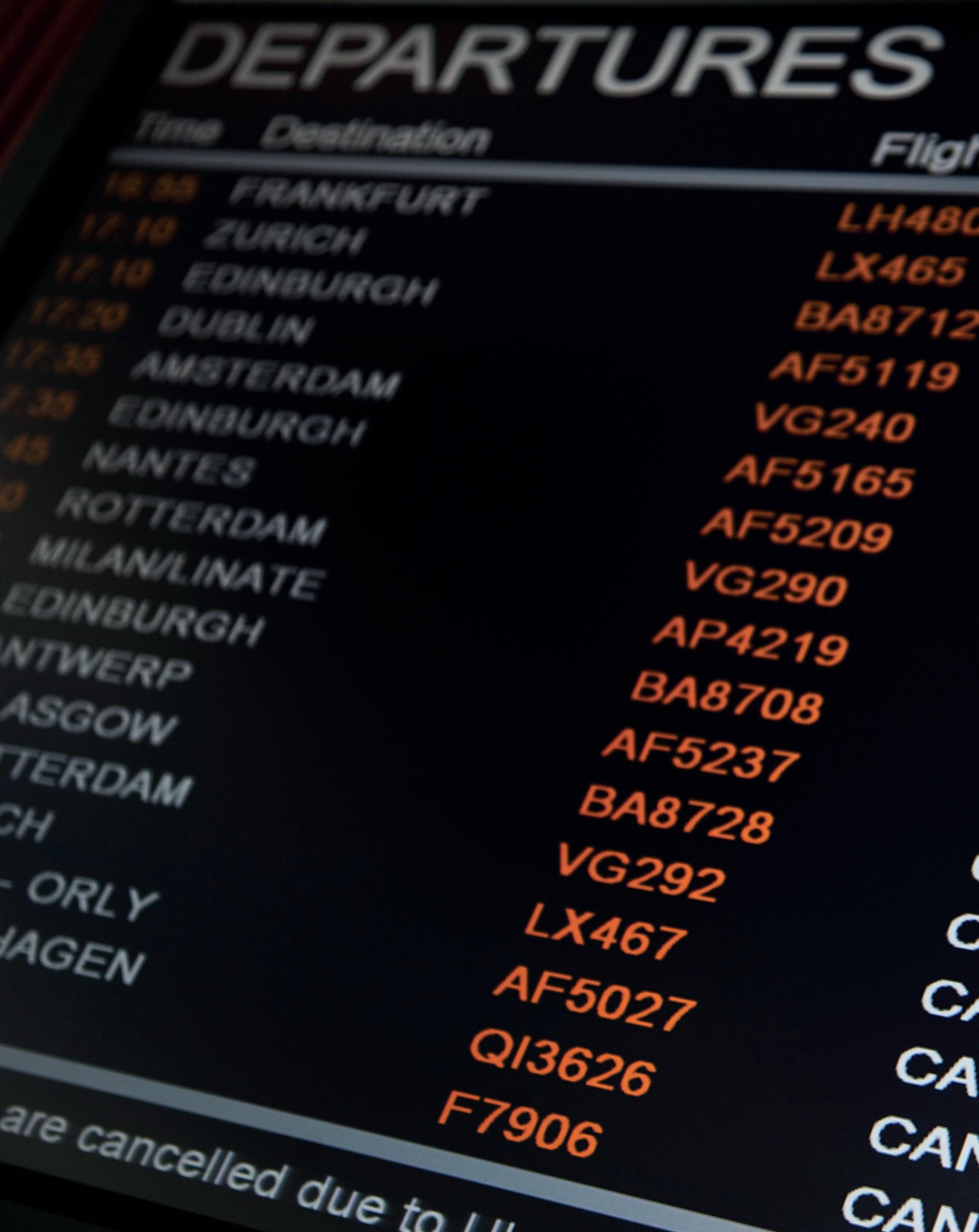
In August, the UK’s National Air Traffi c Services’ (NATS) systems failed, forcing cancellations and delays to fl ights. Yet airlines had to pay for this fi asco, not NATS. Airlines cared for customers and untangled disrupted crew and aircraft schedules. The passenger rights system must be rebalanced so there is greater accountability across the value chain.

7 2023 – 03 Airlines The Big Picture
THE FUTURE OF MODERN RETAILING. TODAY.
Many of today’s travel customers use online travel agencies (OTAs) because they can do everything in one booking. Their hotel, onward transport, and other ancillaries are all just a click away.
Airlines struggle with this offer flexibility because of the legacy systems and processes that limit how they can hold, share, and exploit data.
“Airlines must transition to the modern offer-order environment,” says Alex Mans, FLYR’s Founder & CEO. “It is the only way to meet the needs of today’s traveler. But the good news is that the ability to do so is available now. It is not difficult for any airline, no matter the state of their current systems, to transition to an offer-order platform and thereby reduce costs and increase revenue.
“The perception is that we are three to five years out from implementing offer and order, but that is not true,” he adds. “FLYR has offer and order capabilities in place with major airlines today, with others to be announced in the first half of 2024. This is happening, and it is happening quickly. Soon everyone will want to follow, but the ‘go time’ is now.”
Commerce Engine
FLYR’s Commerce Engine is designed to enable airlines to sell what they want to
who they want without constraint.
The Commerce Engine comprises four products:
An Offer Management System for airlines to meet customers in the channel of their choice.
An Order Management System based on the ONE Order standard.
A Product Catalog that enables selfservice management of all primary and third-party product and sales conditions. New Distribution Capability (NDC) for rich-content offer and order orchestration.
Airlines can therefore keep track of a full portfolio of offers, including such third-party products as insurance and rail tickets, and, of
Alex Mans, FLYR’s Founder & CEO

course, manage inventory and pricing. This equates to massive revenue potential. Most importantly, airlines can also benefit from order management. Mans explains that IATA’s ONE Order standard is a step change in capability.
“ONE Order is an open standard, whereas previously this sector operated on closed standards that connected particular systems,” he says. “This means you can get all your information onto one platform, including customer loyalty. And that is the key to successful order management.”
Ready for implementation
FLYR takes clients through from an initial consultation to full implementation. In 2022, the company acquired Newshore, a Barcelona-based software business, and Pribas, a German company, both of which specialize in the practical side of modern retailing.
“When FLYR started, we looked specifically at revenue management and optimizing seat sales,” says Mans. “We used deep learning and artificial intelligence to suggest pricing, and through this, quickly saw the potential of forecasting across a range of commercial decisions. This led to an involvement in other products and travel verticals, such as hotels.
“We wanted to make sure our clients could action our insights and fulfill complex orders, so we acquired Newshore and
“Airlines must transition to the modern offer-order environment. It is the only way to meet the needs of today’s traveler”
Alex Mans, Founder & CEO, FLYR
Alex Mans, FLYR’s Founder & CEO, explains how FLYR can exceed traveler expectations, without legacy constraints.
8 Airlines 2023 – 03 airlines.iata.org Sponsored Feature: FLYR
Pribas to make that a reality. Our vision has always been to help companies break free of legacy technology, and now we can bring all the relevant elements under one umbrella and one brand.”
Airlines still have work to do, and some departments are ripe for development. Mans reports that, in his experience, marketing is in the right mindset and eager to deploy dynamic offers, while revenue management and accounting understand how new tools will simplify processes.
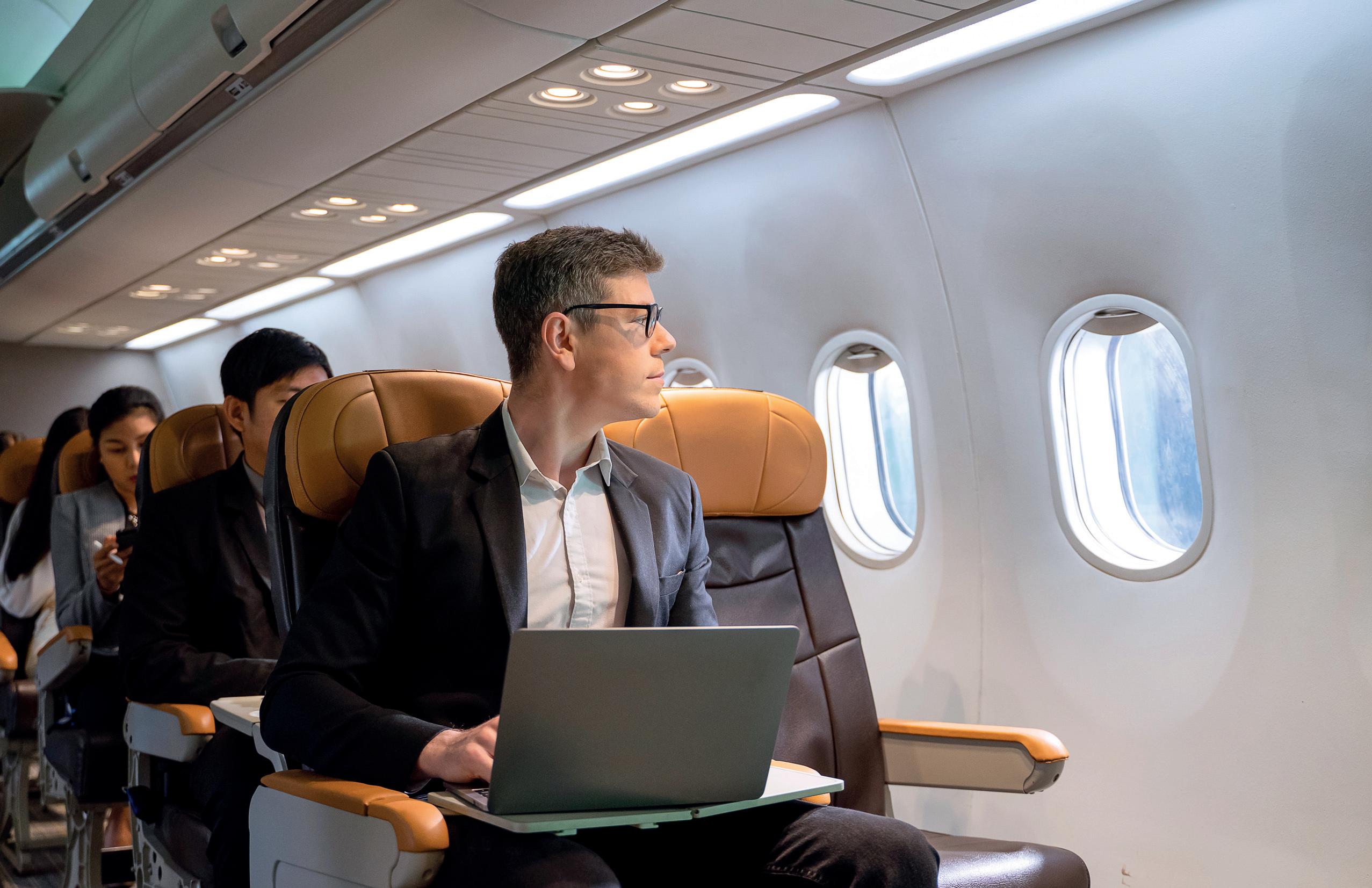
Competing priorities prove that there is still work to be done, such as highlighting timely advantages. “The signs are good, though,” says Mans. “For example, contracts on Passenger Name Record (PNR) data and Passenger Service Systems (PSS) are shortening, indicating that changes are coming.”
Mans says commercial leaders are beginning to see the value in data these and other systems hold. “Airlines must be more aggressive about data they own,” he concludes. “They have incredible opportunities within that data. At FLYR, we use deep learning and AI to help airlines turn the data they own into better commercial decisions and personalized offers to travelers. As a result, airlines experience reduced cost,
more revenue, and satisfied customers— successfully rivaling the best retailers in the business by giving travelers what they want.”
See how FLYR’s Commerce Engine is making modern retailing a practical reality, not a future promise. Visit www. flyr.com/airlines/commerceengine.
“At FLYR, we use deep learning and AI to help airlines turn the data they own into better commercial decisions and personalized offers to travelers”
IMAGES: ISTOCK 9 2023 – 03 Airlines airlines.iata.org
Alex Mans, Founder & CEO, FLYR
FLYR: Sponsored Feature
Digest
IATA calls for Sri Lankan aviation blueprint


IATA urged Sri Lanka to develop an aviation blueprint to generate greater economic growth and prosperity through a stronger aviation industry.
“Aviation connectivity can play a much bigger role in Sri Lanka’s economic development and social advancement,” said Philip Goh, IATA’s Regional Vice President for Asia Pacific. “But this will not happen by chance. Government support will be critical to growing a strong airline sector and developing Colombo as an aviation hub. We urge the government and all industry stakeholders to collaborate on developing an aviation blueprint to strengthen the aviation industry’s competitiveness and bring greater prosperity to Sri Lanka. And IATA stands ready to support through
our expertise and sharing of industry best practices.”





Aviation has a role to play in 15 of the 17 UN Sustainable Development Goals. Trade and tourism rely on aviation, and this helps to create jobs, alleviate poverty, and generate prosperity. In a 2018 IATA study, Sri Lanka’s aviation sector supported some 700,000 jobs and contributed $8 billion to GDP. This has the potential to increase to over 1 million jobs contributing nearly $30 billion to the GDP by 2038.




In his keynote remarks at Aviation Day Sri Lanka, organized by IATA and the Civil Aviation Authority of Sri Lanka (CAASL), Goh suggested three areas to consider in the aviation blueprint:
Facilitating Sustainable Growth: “Sri Lanka’s aviation blueprint needs to facilitate the sustainable growth of the industry and having an updated airport masterplan is the first step,” said Goh. “As traffic grows, digitalization will be key... IATA’s One ID and One Record initiatives can help support this.”
Safety: Goh encouraged the government to explore how the IATA Operational Safety Audit (IOSA) and IATA Safety Audit for Ground Operations (ISAGO) can be used to contribute to greater aviation safety in Sri Lanka.
Sustainability: “I am delighted that net zero carbon from aviation by 2050 is one of the stated policy goals of Sri Lanka’s sustainable aviation environment policy, including the need to ensure the availability of sustainable aviation fuels (SAF) in the country,” said Goh.
IMAGES: ISTOCK
10 Airlines 2023 – 03 airlines.iata.org
Improving safety in Africa
IATA is launching the Collaborative Aviation Safety Improvement Program (CASIP) to reduce the accident and serious incident rate across Africa as part of the Focus Africa initiative. Launch partners in the program are:
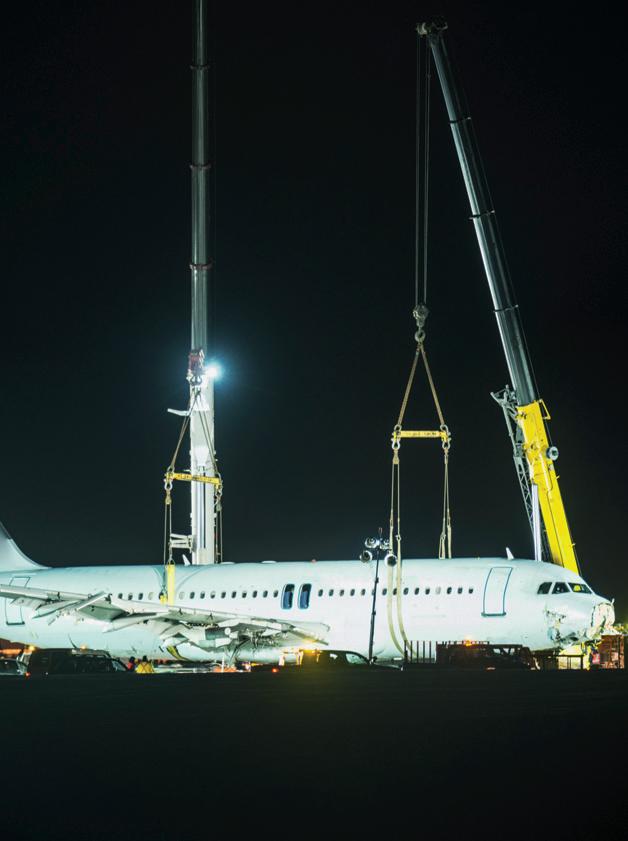
The International Civil Aviation Organization (ICAO)
The African Civil Aviation Commission (AFCAC)
The US Federal Aviation Administration (FAA)
Boeing
The Airlines Association of Southern Africa (AASA)
Together, the CASIP partners will prioritize the most pressing safety concerns on the continent and rally the resources needed to address them. The benefits of improving aviation safety in Africa will be spread across
the economies and societies of the continent. “Improving aviation safety will play an important role in Africa’s overall development. Safe, efficient, and reliable air connectivity is a major driving contribution to the UN’s Sustainable Development Goals. In that sense, CASIP will make it clear to governments across the continent that aviation must be prioritized as an integral part of national development strategies. With such broad benefits at stake, we hope that other parties will be encouraged to join the CASIP effort,” said Willie Walsh, IATA’s Director General.
At government level, a key indicator is effective implementation of ICAO Standards and Recommended Practices (SARPS). Data for 2022 reveals room for improvement with only 28 of 54 African states reaching an implementation rate for ICAO SARPS of 60% or higher.
KONG’S AVIATION FUTURE LOOKS BRIGHT
IATA welcomed the Hong Kong Special Administrative Region (SAR) government’s efforts to ease the city’s labor crunch in the aviation sector. This comes as IATA upgraded passenger traffic projections for Hong Kong that now see a recovery to pre-crisis levels by the end of 2024.

IATA called on governments to live up to longstanding international treaty obligations to publish timely and thorough aviation accident reports. Failure to publish prompt and complete accident investigation reports deprives operators, equipment manufacturers, regulators, infrastructure providers and other concerned stakeholders of critical information that could make flying even safer.
The requirements of the Convention of International Civil Aviation (Chicago Convention) Annex 13 are clear. States in
charge of an accident investigation must:
• Submit a preliminary report to the International Civil Aviation Organization (ICAO) within 30 days of the accident.
• Publish the final report, that is publicly available, as soon as possible and within 12 months of the accident.
• Publish interim statements annually should a final report not be possible within 12 months.
Only 96 of the 214 accident investigations during the period 2018-2022 conform with the requirements of the Chicago Convention.
“The situation is looking bright for Hong Kong. China’s earlier than expected reopening is providing a muchneeded boost to the passenger recovery. By the end of 2024, we expect to see Hong Kong’s traffic return to pre-crisis levels. And it is encouraging to see the Hong Kong government preparing for this with measures to ensure that the workers needed to support the recovery are available,” said Willie Walsh, IATA’s Director General. Although demand for air travel has been strong, airlines in Hong Kong have been struggling with supply chain issues and a labor shortage.
“The accident investigation process is one of our most important learning tools when building global safety standards”
Willie Walsh, IATA’s Director General
Aviation accidents: IATA reminds governments to publish thorough and timely accident investigation reports
ACCIDENT REPORTS ESSENTIAL TO IMPROVE SAFETY
11 2023 – 03 Airlines airlines.iata.org Digest
HONG
In numbers
Some small electric aircraft concepts could require up to 2-3 megawatts of energy for fast recharging. In comparison, mid-sized airports today use 30-50 megawatts of power
21,200,0
The amount of carbon aviation must mitigate
to achieve net zero by 2050, assuming business as usual operations
5tn
Achieving net zero by 2050 could cost up to $5 trillion or $180bn every year
100m tonnes
Aviation could require 100 million tonnes of green hydrogen by 2050, roughly today’s total production, 99% of which isn’t green
NET ZERO ROADMAP Source for most of the data and charts (unless specified): IATA’s ‘Finance, Net Zero Roadmap’ report 12 Airlines 2023 – 03 airlines.iata.org Data
00,000tonnes By 2050, technological improvements in aircraft could reduce inflight energy by about 7%, lowering the projected total use from 27 to 25 exajoules (in 2019 it was 13 EJ) hydrogen fuel cell and gas turbine patents filed in 2020, up from 22 in 2011 7% 87 202320302035204020452050 The top bar in the chart above shows the baseline CO2 emissions projected for 2050. The subsequent bars show the abatement contribution of each specific technology or improvement which together can bring aviation’s CO2 emissions to net-zero in 2050. The black lines represent the range of uncertainty around the estimates, pertaining to factors including the timing and speed of implementation, the impact of policy initiatives, and the availability of finance. Accelerating technology development and SAF scale-up beyond current expectations could lead to higher-than-anticipated CO2 emission reductions, but equally, any delay in deployment would result in higher residual emissions in 2050. Aviation is currently responsible for approximately 2.4% of global CO2 emissions. Without action, those emissions are estimated to reach around 2 gigatons by 2050. Baseline Efficiency improvements Hydrogen Operations SAF Carbon removals 05001.0001.5002.000
to
Aviation CO2 emissions (in million tonnes) in 2050 (Source: IATA Sustainability and Economics) SAF & CO2 capture infrastructure SAF production and blending capacity scale-up New SAF pathways become commercially available: FT and AtJ SAF production and blending capacity reaches 24 Mt/y SAF production and blending capacity reaches 100 Mt/y CO 2 capture capacity reaches 2 Mt/y CO 2 capture capacity excedes 700 Mt/y CO 2 capture capacity reaches 100 Mt/y Hydrogen for SAF and propulsion exceeds 80 Mt Green hydrogen scale-up for pure use and for SAF SAF production exceeds 400 Mt/y NET ZERO CO2 13 airlines.iata.org 2023 – 03 Airlines Data 2050
Getting
net-zero aviation – a bottom-up roadmap approach
Positive positioning
Patrick Healy, Cathay Group Chair, believes Hong Kong is well-positioned to resume its status as a world-class aviation hub.

WORDS: GRAHAM NEWTON
Compared with the majority of the world’s airlines, Cathay Group was hit worse by the effects of the pandemic, with almost three full years of COVID-19 affecting its operations.
Is the airline on course to fully recover from the pandemic?
Hong Kong and the Chinese Mainland opened again in January 2023 and by March we had exceeded 50% of pre-pandemic traffic levels as a Group. By the end of the year, we aim to achieve 70% of 2019 levels, with more than 80 destinations served. We anticipate a full recovery in 2024.
We’re very confident in our product too, both in the cabin and on land. Our goal remains to be the best service brand in the business and that means having the best cabin and lounges.
Of course, there are challenges. The re-certification of staff is one. We had crew quarantining at home after every roster as late as September 2022. Getting everybody re-certified and getting all the aircraft ready to fly again has been difficult. But the downtime meant we could make sure our planning was good and we are seeing the benefits of that with an accelerated recovery.
How have the prolonged travel restrictions affected you? Do you feel you’ve lost presence in overseas markets, for example?
Hong Kong and the Chinese Mainland opened later than anybody, even in Asia-Pacific. So, yes, our market presence was affected. Our competitors were up and running 12 months earlier than us.
But the main point is that our recovery is faster than most. The lost time is being
14 Airlines 2023 – 03 airlines.iata.org CEO Interview







airlines.iata.org 2023 – 03 Airlines 15 CEO Interview
“Our potential for future growth is enormous. There is central government support for Hong Kong as a global aviation hub”
compensated for by a speedier rebound that will see us achieve a higher base than we had pre-pandemic.
Moreover, our potential for future growth is enormous. There is central government support for Hong Kong as a global aviation hub and they are developing the Guangdong-Hong Kong-Macao Greater Bay Area too.
That means the center of gravity will shift from Hong Kong, with a population of 7 million to the Greater Bay Area, with a population of 87 million. That’s more than a 10-fold increase in our catchment area. Ultimately, all these areas will be connected seamlessly so it will be easy to get on a train in Guangdong and fly from Hong Kong on Cathay Pacific or HK Express.
We have a strategy to maximize these opportunities based on:
Premium travel with Cathay Pacific
Low-cost travel with HK Express Cargo
Lifestyle products.
When that crystal-clear strategy is combined with the opportunities provided by the Greater Bay Area and the improvements at Hong Kong International Airport (HKIA), Cathay has a really exciting future.
How does HK Express fit into your strategy?
The low-cost carrier (LCC) sector in Hong Kong is underdeveloped compared with other parts of Asia. There will certainly be major growth in this market segment, and we will have first mover advantage. HK Express is still a small operation at the moment, but we are determined to press home our advantage. We have done a lot of work on the two brands and potential strategies, and we decided to keep them as separate as possible. You cannot have a genuine LCC and merge it with a premium, full-service airline like Cathay Pacific. But if HK Express sees possible synergies, then we will act on that. The point is that the LCC must be the driver for any interaction. HK Express can pull but Cathay Pacific can’t push.
Are the developments at HKIA enough for your future strategy?
HKIA was smart during the pandemic and used the time to test and implement new technologies. There is now facial recognition at check-in, for example. Most importantly, we will have the third runway operational at the end of next year.
So, by December 2024, Cathay will be fully recovered, with a state-of-the-art airport and a three-runway facility.

How important has cargo been to your overall business?
Cargo was a life saver and critical to our survival during the pandemic. Many airlines would probably say the same about their cargo operations.
The best thing about our cargo team was the speed with which it adapted to the new reality. Even in a highly regulated environment it was remarkably agile. It had preighters, it safely
By the end of the year, we aim to achieve 70% of 2019 levels, with more than 80 destinations served. We anticipate a full recovery in 2024
16 Airlines 2023 – 03 airlines.iata.org CEO Interview
Cargo was a life saver and critical to our survival during the pandemic
carried huge shipments of sensitive vaccines, and it stepped up to the demands of e-commerce.
Remember, supply chains were severely disrupted too, so the network was constantly being adjusted. Despite all this, the sector maximized its opportunities.
What work are you doing in sustainable aviation fuels?
It is imperative that aviation comes together to address the net-zero carbon emissions challenge. And sustainable aviation fuels (SAF) will play the largest role in our efforts. New technologies, such as hydrogen, are exciting, but they won’t be common before 2050.
We made an investment in a SAF production company back in 2014 and that will help us get to 2% uptake by 2030. We want to achieve 10% uptake by 2030 but that will take a sizeable increase in SAF supply.
Any government that aspires to have major aviation hubs must move quickly to support SAF uptake. The issue is supply, not demand. Airlines have made big commitments as evidenced by the number of forward purchases. This is despite the fact that we know there is extra cost involved. At Cathay, we will pay that premium as long as there is a level playing field. There has to be parity in the cost of SAF to encourage uptake.
At the moment, supply is good on the US west coast because they have the right regulatory and incentive framework. That doesn’t need to be replicated exactly—every country will have a different suite of solutions— but it does show the value of supportive policies. Governments must provide the right structure for SAF production at scale.
I don’t object to mandates in principle but a mandate without supply is simply a cost, for airlines and consumers. It delivers nothing for the environment. We must focus on the supply issue first.
What qualities are required to lead a modern airline? Is the skillset changing?
87 million
The center of gravity will shift from Hong Kong, with a population of 7 million, to the Greater Bay Area, with a population of 87 million





It is changing. Although this is a specialist industry and people who have that expertise will always be important in terms of future leadership, a fresh pair of eyes has become increasingly important. You need to reflect customer requirements and there will be new travelers in the years ahead with different needs and attitudes.
The positive thing is that this naturally leads to diversity in leadership. Having a breadth of views and diverse management teams will generate the leaders that this industry needs going forward.
Of course, there are some business fundamentals that are not changing. You must be customer-centric, relentlessly focused on costs, keep your people engaged, and pursue excellence in operations.

“Our recovery is faster than most. The lost time is being compensated for by a speedier rebound that will see us achieve a higher base than we had pre-pandemic”
17 2023 – 03 Airlines airlines.iata.org CEO Interview
IATA Safety Issue Hub promises further safety
Mark Vincent, IATA’s Head of Safety Risk and Quality Assurance says the Hub has long provided value as a risk register. “It is a self-service digital platform where members get access to information regarding global aviation safety issues, risk assessments, and mitigation guidance material,” he informs. “A world map highlights particular safety challenges according to location. For each challenge, there is a description of the risk and the links to guidance material and other information that will help manage that risk.”
Vincent stresses that the safety challenges are not related to specific airlines—all such details are anonymized—but rather the information comes from various audits and programs, including the datasets controlled and analyzed by IATA.

Benefits of the IATA Safety Issue Hub include: Access to a comprehensive knowledge repository that promotes well-informed decisions regarding safety.
The ability to prioritize safety improvement
The IATA Safety Issue Hub has been revamped to further enhance its effectiveness as an internationally recognized repository of aviation hazards.
WORDS: GRAHAM NEWTON
18 Airlines 2023 – 03 airlines.iata.org Safety challenges
benefits
programs according to operational scope, including targeted mitigation strategies. Collaboration among IATA members, industry organizations, and regulators.
Hub upgrades
Following the upgrades, however, the Hub is moving into a new phase. Users are now able to filter by key risk areas, such as controlled flight into terrain, to help research safety programs. Filtering by domain—airworthiness or maintenance, for example—is also possible. This streamlines the effectiveness of the platform and avoids users having to search through reams of information.

“The purpose is to support airlines in maturing and supplementing their safety management systems and to provide an overview of global risk,” says Vincent.
“The IATA Safety Issue Hub will become a one-stop-shop for industry safety information and initiatives.”
The Hub upgrades will also assist in the ongoing transformation of the IATA Operational Safety Audit (IOSA) to a riskbased model. Regional issues and needs will be better understood and allow audits to be targeted correctly. Airlines in Africa will have different concerns to US carriers, for example. This can be refined even further to focus on a particular destination or topic.
Real-time conversations
Vincent says that getting more input into the Hub will be vital and determine its level of success. “We can take the information we have and provide the big picture, but we need all industry partners, including airports and air navigation service providers, to contribute and help complete the picture. An issue at an airport might be more easily identified and we could then influence the necessary changes.
“We do get some input already but there is an opportunity to do so much more,” he adds. “We can dig deep into particular issues and identify notable trends in the ICAO Standards and Recommended Practices.”
To support the call for greater input into the Safety Issue Hub, the web-based platform will remain publicly accessible and free of charge for the foreseeable future. Potential improvements to safety should never be placed out of reach financially or otherwise, especially for those airlines still maturing their safety management systems, says Vincent. Everything on the platform is completely transparent to encourage the sharing of safety data.
Ultimately, the longer-term aim is to transform the Safety Issue Hub into a safety community where real-time conversations can take place and all airlines can take advantage of the expertise on offer.
“The IATA Safety Issue Hub is of benefit to the entire aviation value chain,” Vincent says. “Risk is often identified and managed in silos. The upgrades to the Hub will change this and allow the industry to collectively design safety improvement programs to effectively mitigate operational risks.”
Use the QR code below to take you directly to IATA’s Safety Issue Hub, where members are encouraged to contribute to the Hub by sharing any identified issues

“The IATA Safety Issue Hub will become a one-stop-shop for industry safety information and initiatives”
Mark Vincent, IATA’s Head of Safety Risk and Quality Assurance
Regional issues and needs will be better understood and allow audits to be targeted correctly. Airlines in Africa will have different concerns to US carriers
IMAGES: GETTY/ISTOCK 19 2023 – 03 Airlines airlines.iata.org Safety challenges
BEING SUCCESSFUL IN THE WORLD’S BIGGEST TEAM
Aviation staffing issues as the recovery nears completion are well documented. During the pandemic, the industry lost huge numbers of skilled personnel from a workforce that was already on the lean side. Demand for air travel has picked up faster than expected and so the staffing shortfall has become pronounced.
But Anko van der Werff, CEO, SAS, doesn’t believe there are structural issues. “The industry just needs to find it mojo again,” he says. “It needs to remind existing staff and potential recruits that this is an innovative, groundbreaking, global industry. The pandemic was rough on everybody, and aviation staff were stressed. We were ramping up, ramping down again. It was really tough.”
For van der Werff, the key is to create a culture that addresses the difficulties of the past few years and those employees that endured them while also appealing to potential talent. Doing so means being
honest and transparent about the personnel challenges ahead.
Industry experience
For many, in these cost-conscious times, renumeration is all important. “Staff had to take pay cuts, forego bonuses, or go on furlough when the pandemic hit,” says van der Werff. “And now, air travel demand has returned to pre-pandemic levels, inflation is high, but industry salaries are not moving upward. That is asking a lot of existing or new staff.”
As is the case with many airlines, however, SAS is not in a position to splash
the cash. The airline is going through a restructuring and is not yet profitable. Moreover, it still operating under state aid rules meaning its hands are tied when it comes to salary adjustments and bonuses.
“Airlines are at different stages of recovery, some have state aid rules, and others have more financial flexibility,” says van der Werff. “It means there will be plenty of movement within the industry.”

The SAS CEO says aviation experience is still crucial. The airline’s last three senior management recruits all have extensive industry skills and knowledge.
The search is on for a new SAS Head of
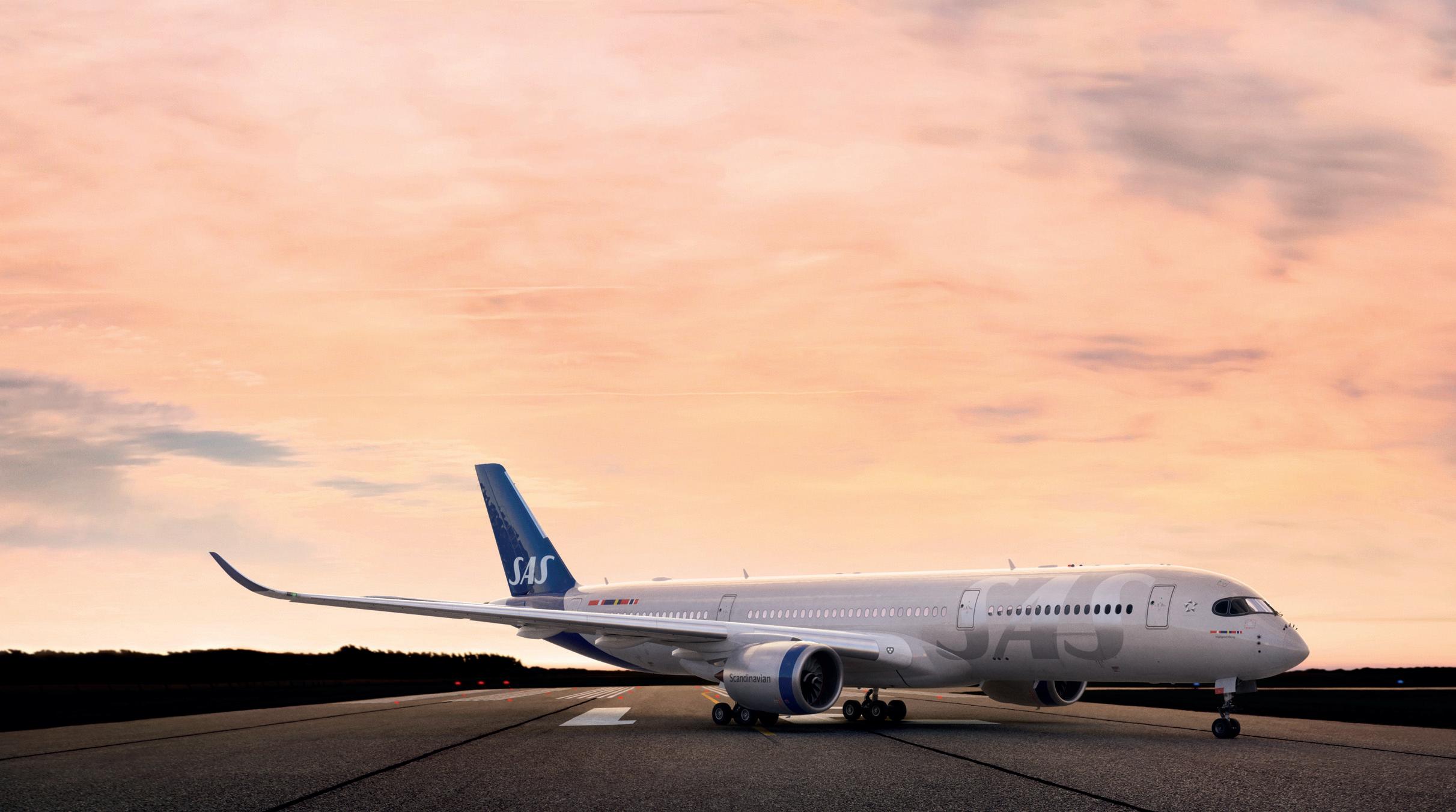 Anko van der Werff, CEO, SAS
Anko van der Werff, CEO, SAS
“There are simply not enough airline people, so you have to look at other sectors. Airlines previously under-recruited and so the only way forward is outside hires”
Anko van der Werff, CEO, SAS
Anko
van der Werff, CEO, SAS, discusses the importance of creating the
right company culture.
Sponsored Feature: Venari Partners 20 Airlines 2023 – 03 airlines.iata.org
Maintenance and experience and the ability to instantly command respect are essential, according to van der Werff. “We have a lot of work to do and taking the time to explain the nuances of the industry is often a luxury we can’t afford,” he admits. “If we need to recruit in revenue management, we need someone who understands airline revenue management.”
Nevertheless, van der Werff accepts that the industry need for staff is such that outside hires are inevitable. “There are simply not enough airline people, so you have to look at other sectors,” he says. “Airlines previously under-recruited and so the only way forward is outside hires.”
Fortunately, there are sector-agnostic functions, in finance or commercial, for example. And although matching salary levels in other industries is hard, van der Werff says recruiting from other industries does have some benefits. “It brings fresh perspectives and that is a good thing when it is balanced against industry knowledge,” he says. “It facilitates a culture where asking
a question is okay. That helps make an airline more customer focused. Specialists can sometimes get lost in technicalities and it is always good to be reminded of the big picture.”


Outside hires also promote diversity. In Scandinavia, diversity is established but, even so, just 5% of SAS pilots are female. “We must do better, but it is diversity of thought and opinion that is most important. Our management team at SAS, male and female, have worked all over the world and that is crucial to fostering diverse thinking.”
Creating a culture
The SAS CEO accepts it is his job to create a uniform culture out of this diversity. SAS does regular staff surveys and engagement is close to an all-time high. All staff, whether experienced or and new recruits,
must pull in the same direction. It will take time to achieve but van der Werff says that culture starts at the top and flows down.
“I like to walk around and see what is happening,” he explains.
“I am genuinely curious, and I think that is an important trait for a CEO. It leads to transparency and honesty. can voice concerns and I can share those concerns and engage with them.
“But, of course, I cannot de-ice or push-back. So, I am not the most important person in the airline. The truth is that aviation is the biggest team sport there is. And we all must play our role to make the team successful.
“I think SAS and the industry have a lot to be optimistic about,” he concludes. “We’ve had a difficult few years, but I’m really positive about the future.”
“Our management team at SAS, male and female, have worked all over the world and that is crucial to fostering diverse thinking”
IMAGES: SAS AB Venari Partners: Sponsored Feature 21 2023 – 03 Airlines airlines.iata.org
Anko van der Werff, CEO, SAS

22 Airlines 2023 – 03 airlines.iata.org CEO Interview
“Prior to the pandemic, DFW had over 900 American Airlines departures every day and it will be back there before too long and go even higher”
Reliability and a return to profitability
WORDS: PERRY FLINT
From a leader in its use of sustainable aviation fuels to striving to be an industry leader in diversity, American Airlines is looking forward to continuing its profitability, increasing customers, and improving the travel experience.
What are the airline’s priorities for 2023?
The pandemic was a tough period, but I felt we did all the right things to prepare for demand coming back—and we knew it would.
Our focus has been on running a reliable airline and getting back to profitability, and ultimately rebuilding and enhancing our balance sheet, which means reducing leverage. And I think we have done a lot of great work so far.
From an operations perspective, we’ve never had a stronger start to a summer, and we’re coming off some of the most successful quarters we’ve ever had. From a financial perspective, we returned to profitability last year. We’ve had four consecutive quarters of profitability and we anticipate another one coming up [second quarter of 2023].

We’ve made great progress on strengthening our balance sheet and the team is coming together to deliver every day for our customers. So, I feel really good about where we are.
Can you discuss your hub structure?
Our hubs are the most critical aspect of our operation. One of the great things about American is that we offer more origins and destinations than any other airline. We go from small cities to big cities to international destinations. When you add our partners into the mix, through oneworld and our joint business partners and other relationships, we have the best network in the world.
And this network is anchored by really large hubs, Dallas-Fort Worth (DFW) being the largest. Prior to the pandemic, DFW had over 900 American Airlines departures every day and it will be back there before too long and go even higher. It’s facilitated by the new investment we’re making at DFW: a nearly $5 billion investment over the next 10 years, which will include major modernization and gate expansion projects that will give us the capacity to grow.
Robert Isom, CEO, American Airlines, tells Perry Flint that the carrier’s solid operational performance is the bedrock for an array of improvements.
23 2023 – 03 Airlines airlines.iata.org CEO Interview
We’re fortunate to have our biggest hubs located in the fastest growing regions in the United States, both in terms of the local economies and the population. In this respect, DFW is joined by Charlotte, Phoenix, Miami, and by the northern hubs in Philadelphia, New York, Washington, and Chicago—and Los Angeles as well. We’re making a big investment in Charlotte too because we see a world where Charlotte grows considerably. We’re starting with some improvements on the tarmac— there’s a new dual taxiway and we’re breaking ground on a new runway.
And at Ronald Reagan Washington National Airport in Washington DC, we have worked very closely with the Metropolitan Washington Airports Authority to produce one of our best terminals from a passenger perspective, in terms of flow and amenities. The new Admirals Club lounge there is something to behold. And that’s in addition to the work at New York JFK, where we’ve looked at Terminal 8 in a completely different way with our oneworld partners, including British Airways. We completely redesigned some aspects of T8, including the check-in area and a new baggage system.
In fact, there are development projects going on just about everywhere we operate. That’s a testament to the demand for our network and we are investing in ways that are really going to make a difference.
Why have you decided to be a leader in changing the approach to corporate travel?
We want to meet customers where they want to shop and do business. We have to be able to offer the full range of products and services to our customers and the only way to do that is to ensure that the technology and tools are accessible. We have made bold moves and though it’s still early days, we can already see that it’s paying off. Our customers are certainly benefiting—we’ve never seen so many who transact directly with American. No doubt it has taken time and investment, but customers are better served.
How does the New Distribution Capability fit into this?
This is about being able to offer a modern airline retailing experience. In all respects, NDC is enabling us to deliver what customers want when they want it and how they want to receive it.
How are disruptions in the aviation supply chain affecting your capacity and schedule planning? Airlines are no different from any other industry. We had to come out of the pandemic in quick order and it’s taking time to catch up. In 2021 and 2022, we had to make sure we were staffed appropriately for the level of operations we wanted to achieve. We studied 2022 extensively, especially during the summer, to make sure we could meet customer expectations. As mentioned, the aim is to run a reliable airline.
I have great confidence we can do that, but we must size the airline according to our resources. That includes aircraft and engines, which are the biggest pipes in the supply chain. But getting aircraft delivered on schedule hasn’t happened for some time. So, we have had to build more buffer into our systems.
We’ve also had issues with catering, fuelers, and airport services. But we’ve worked with everybody, including government agencies, and we’ve sized our operations appropriately. We put out a capacity plan at the start of the year and we’re flying that. But that’s not because the supply chain has worked, it’s because we built in buffers.
There was also a constraint with the supply of pilots, but we’ve seen a great improvement there. We took the initiative because we weren’t attracting enough aspiring aviators into the business. Last year. we significantly increased the salaries for pilots at our wholly owned regional carriers. That has benefited regional airlines in the short term and also created a supply of pilots that will feed into mainline operations. We will hire some 1,500 pilots this year and that will help us achieve about a 5%-8% capacity growth over 2022. And

24 Airlines 2023 – 03 airlines.iata.org CEO Interview
1, 500 We will hire some 1,500 pilots this year and that will help us achieve about a 5%-8% capacity growth over 2022
we’re working closely with our colleagues in government on ensuring, for example, there are enough air traffic controllers.
You are committed to using 10% sustainable aviation fuels by 2030. Can you hit this target and the other sustainability goals?
We received the Eco-Airline of the Year award from Air Transport World in June. I’m proud of that; it comes from a very broad effort in terms of sustainability. One way to reduce carbon emissions is to fly a newer, more fuel-efficient fleet. Each new generation of engines saves about 15% fuel burn. We’ve spent almost $30 billion over the past 5-8 years in capital.
Then you have to think about what you put in the engines. We are a leader in using sustainable aviation fuels (SAF). We’ve committed to purchase more than 620 million gallons of SAF, including 500 million gallons from Gevo over the next five years, to work towards our goal of replacing 10% of our fuel with SAF in 2030. We will need these partners to be able to develop and scale their operations over the next few years to meet our commitments. We also worked with Congress on the new federal blenders tax credit and the State of Illinois to get a tax credit. Other states are also considering SAF tax credits, and we will continue to advocate for policies that will support more SAF production.
We also joined Breakthrough Energy Catalyst as an anchor partner, committing $100 million. Breakthrough works with a number of other leading companies to address and accelerate climate saving technologies including SAF, green hydrogen, long duration energy storage, and direct energy capture.
We won’t achieve net zero on our own. Industry needs to double down on investment in SAF production, and find ways to become more efficient in aircraft routings. That will require more work in Washington on air traffic control modernization to make use of the full capabilities of our aircraft. I’m proud of where we are but there is a lot more to come.
Can you discuss the importance of diversity to American and the industry?
We have efforts underway on all fronts. We’re a people business. American serves 600,000 customers a day. Just at the mainline we have 120,000 people who serve those customers. So, our team covers every race, nationality, religion and much more.

Diversity, equity and inclusion is foundational. It’s something we constantly strive to embed it into the fabric of who we are because it is essential to carrying out our mission. We’re going to lead the industry. This is going to be a place for all generations, races, ethnicities, genders, sexual orientations. Everyone needs to feel welcome.
What is your view on creeping US reregulation?
First, I’d like to thank Secretary of Transportation [Pete] Buttigieg for his partnership and engagement with our industry. We’re an industry that the country depends on, and at the end of the day, we need to serve our customers well.
We have a vested interest in serving our customers in a way that they feel appreciated, they get value for their money, and they are transported safely. We take that very seriously. We already have the motivation to do that because that is our business. Our goal is to care for the customer.
We’ll continue to work with the Administration, but when there are disruptions, they are usually related to weather. And weather is just another word for safety. And there is an overriding obligation to ensure airline customers are safe.
What keeps you up at night?
I sleep well! And that’s because I have 120,000 team members along with me. We have exceptional talent at every level. They take their responsibilities very seriously. So, I know that when I go to sleep, I’ve got people who are making sure the right things happen at American.
American
25 2023 – 03 Airlines airlines.iata.org CEO Interview
“We’ve made great progress on strengthening our balance sheet and the team is coming together to deliver every day for our customers”
serves 600,000 customers a day. Just at the mainline we have 120,000 people who serve those customers
ENHANCING THE PASSENGER EXPERIENCE AT CPK
Centralny Port Komunikacyjny (CPK) is set to build a state-of-the-art airport hub from scratch, promising a seamless and enjoyable passenger experience.
Drawing on the proven success of the world’s leading airports, CPK is dedicated to delivering the highest standards of services from the outset of a traveler’s journey. This innovative greenfield project offers a significant advantage over established airports, as CPK has the unique opportunity to design and implement a cutting-edge airport interior layout that prioritizes the passenger experience. Additionally, modern retail channels and technology will be seamlessly integrated to enhance and support all operations.
Overall, CPK’s new airport hub promises to revolutionize air travel, providing a world-class gateway for travelers from around the globe no matter what their requirements.
Multimodal experience
Since the passenger experience begins much earlier than the airport entrance, the CPK project aims to ensure easy airport

access, being both a destination and an attractive transfer location where all transport modes meet. The aim is to provide a true multimodal passenger journey, giving customers choice and improving sustainability.
CPK intends to focus on providing its passengers with a pleasant ambience created by natural lighting, green spaces, and services and amenities that focus on
Poland’s new airport will encompass a wide range of innovation to appeal to a diversity of customers.
Airlines 2023 – 03 airlines.iata.org 26 Sponsored Feature: CPK
To support a positive passenger experience, CPK aims to introduce digital signs, biometric solutions, mobile applications, information kiosks, and smart shopping opportunities
the unique needs of the traveler. This will all be underpinned by a human touch created by a professional and hospitable staff. Good wayfinding also reduces passenger stress and therefore, to enhance the experience, CPK intends to implement process-oriented shapes and structures within its buildings that promote natural wayfinding. Another aspect will be minimizing the number of level and direction changes, as well as the walking distances. To support this, CPK plans to implement clear signage systems, with moving walkways and services to assist those passengers with health conditions or other impairments.
As different types of travelers have different needs, CPK aims to provide an infrastructure that addresses all possible


requirements and concerns, including dedicated security control lanes for passengers with disabilities and their families, children’s play areas and nursing stations, quiet zones, pet relief areas, workspaces, prayer rooms, and VIP services with business lounges.
Optimization
Technology is playing an increasingly vital role in modern travel, and CPK will therefore ensure it is at the heart of the passenger journey and make it one of the key components in the gateway’s construction.


To support a positive passenger
experience, for example, CPK aims to introduce digital signs, biometric solutions, mobile applications, information kiosks, Wi-Fi infrastructure, and smart shopping opportunities.




The use of different kinds of systems should allow an optimized queuing time, not to mention light and temperature control, which will facilitate the passenger experience, and make the journey through the airport as seamless and pleasant as possible.
For more information on the new transport hub: Visit https://www.cpk.pl/en/
IMAGES: ISTOCK/SHUTTERSTOCK 2023 – 03 Airlines airlines.iata.org 27
CPK: Sponsored Feature
Automation the key to easing airport congestion
Automating and accelerating passenger processing times are essential to meeting air travel demand.
WORDS: GRAHAM NEWTON
The recovery from the pandemic is almost complete with some 4.4 billion passengers expected to fly in 2023. International traffic has increased from a standstill in April 2020 to reach about 84% of 2019 levels.
With passenger numbers expected to double by 2040, the focus has once again turned to aviation infrastructure on the ground. Already, in summer 2022 there were issues with congestion at key nodes in the air transport network. Both London Heathrow and Amsterdam Schiphol were forced to limit flights, for example. In fact, the majority of the top 100 airports are expected to be capacityconstrained by 2030.
With new airports few and far between, especially in mission-critical cities, the industry’s only option to accommodate demand is greatly improving passenger facilitation through the existing airport footprint. Automating manual processes and even moving them off airport will be integral to the success of this initiative.
“The main reasons passengers need be checked by airline, airport, and border control
agents are for identification, access control, and travel documentation checks, such as confirmation of a visa,” says Alan Murray Hayden, IATA’s Director, Airlines, Airports and Security Operational and Compliance Solutions. “But many of these procedures can all be pushed off airport through a combination of Timatic and contactless travel as stipulated by IATA’s One ID initiative.”
Timatic
Timatic is integrated in almost all airline departure control systems as part of their check-in process, making it an essential element in speeding up passenger processing times and improving throughput.
Timatic is a one-stop verification platform that enables airlines to confirm whether a passenger is eligible to fly. Pre-pandemic more than 700 million passengers per year had their passport details, visa requirements, and other travel-related documentation checked by Timatic.
Typically, about 85% of passengers are green-lighted for travel with various issues red-flagging the remaining 15%. And the whole process is virtually instantaneous, from the

IMAGES: ISTOCK
28 Airlines 2023 – 03 airlines.iata.org Timatic
latest government requirements being inputted to the outcomes of passenger checks.
As robust as Timatic is—and Murray Hayden draws attention to the enormous value it provided during the pandemic when rules could change on an hourly basis—IATA is rolling out an upgraded version as of January 1, 2024, with migration to this platform to be completed by December 31, 2024.
The new version of Timatic AutoCheck will deliver an improved passenger experience, more efficient operations, and reduced costs.
“Before, a passenger trying to check-in online might just have received a note asking them to see an agent,” explains Murray Hayden. “There would have been no explanation, and the situation would have to be resolved at a counter just prior to the flight, causing queues and anxiety.
“Now, a passenger will get explicit information about a problem in clear, conversational language and they will have the ability to upload a visa or other details that will allow them to pursue an automated process.”
In turn, check-in staff are freed up to deliver more value-added services and there is less likelihood of mistakes being made due to time pressure. Airlines avoid costly fines as a result.
Contactless travel
Contactless travel, encapsulated by IATA’s One ID initiative, is the second crucial element in facilitating increased passenger throughput and processing speed without expanding the airport footprint.



One ID will bring multiple benefits to all stakeholders. Passengers will have a muchimproved travel experience and no longer need to juggle between different documents. By having the opportunity to share the minimum data necessary with airlines, airports, and governments prior to departure, passengers can arrive at the airport ready to fly and can pass all airline touchpoints using biometrics.
Queues and repetitive documentation checks will be consigned to the history books. One ID will also enable significant cost savings for airlines and free up staff for value-added services, bringing further commercial opportunities. And governments will benefit from strengthened border control thanks to pre-travel, quality data.
One ID principles include: a paperless process passengers retain control of their personal data ensuring verifying parties request only the minimum data required to complete the transaction a secure peer-to-peer exchange without any third-party intermediaries the ability to opt out of the One ID process and choose traditional manual processing.
Together with Timatic, contactless travel will supply the industry with the tools to meet air travel demand.
“We need to focus on the passenger experience and operational efficiency,” concludes Murray Hayden. “We can do both and a revamped Timatic and contactless travel will provide us with the opportunity.”
“We need to focus on the passenger experience and operational efficiency”
Alan Murray Hayden, IATA’s Director, Airlines, Airports and Security Operational and Compliance Solutions
29 2023 – 03 Airlines airlines.iata.org Timatic
The new version of Timatic AutoCheck will deliver an improved passenger experience, more efficient operations, and reduced costs
PAINTING THE DIGITAL CANVAS
Aviation is continuing its rapid recovery following the pandemic, with some airports already exceeding 2019 traffic levels.
And even though financial and staff resources are depleted following some tough years, the need to deliver a seamless, efficient experience for the passenger is unabated. Customers now expect to pass from ‘curb to gate’ with their personal device providing all the travel documentation they need.
Through the integration of biometrics and artificial intelligence (AI) technologies, operators can deliver a fully unified experience incorporating
digital signage along the entire passenger journey.
Customers have become used to detailed flight information display systems (FIDS) regularly updating information in clear text. But there is far more potential for digital displays, says Simon Hayes, Director of Transportation at Sharp/NEC Display Solutions Europe.

“They might display wayfinding directions to drive efficiency, for example,” he notes. “Airports have become far more expensive to run and the effective use of digital displays can optimize staff allocation and improve the flow of passengers through the terminal. By incorporating AI, content along the journey can be adapted to meet the needs of a specific group of passengers, such as delivering customised information to specifically target passengers off a flight that has just landed.
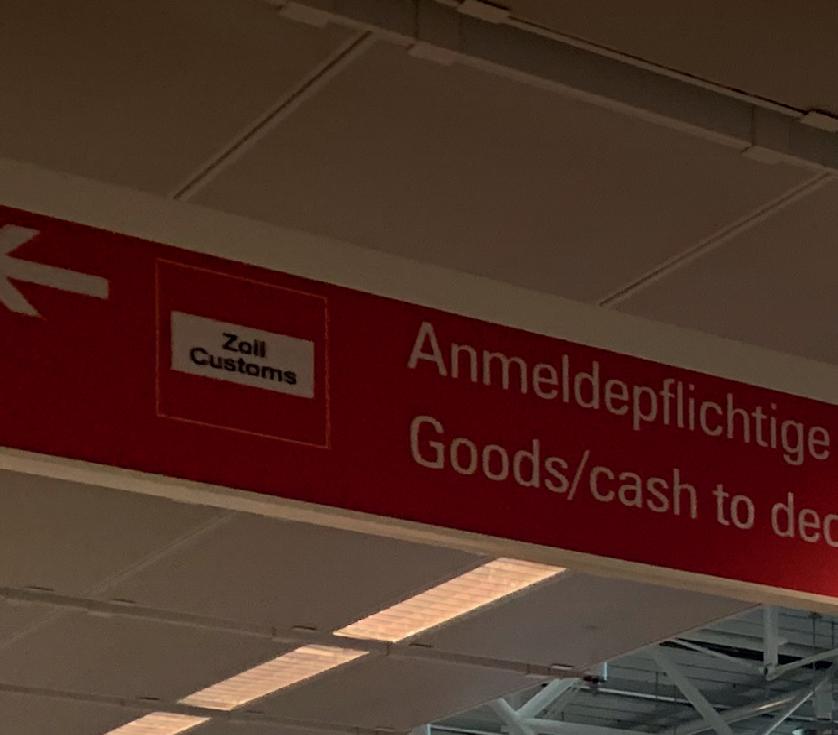
“Airports are destinations in their own right,” he continues. “That means we are going beyond display screen provision for critical information, to creating digital experiences. And those experiences are a blank canvas for the airport.

“Every airport, large or small, has blank or empty space that could be turned into a dynamic, profitable digital environment
with advertising space generating much needed revenue streams. Additionally, screens could show relaxing or uplifting images simply to improve the ambience and help to reduce potential anxiety as passengers await their flight.”
Preferred solution
Direct View LED (dvLED) technology is becoming the preferred solution for multi-purpose digital signage throughout the airport.

dvLED is light, scalable to vast proportions, and provides excellent image quality in contrast and brightness— essential in light-flooded terminals. It is also highly reliable. Sharp/NEC uses an extremely

dvLED—Direct View LED—technology is set to transform the airport experience for passengers.
30 Airlines 2023 – 03 airlines.iata.org
Sponsored Feature: Sharp/NEC Display Solutions
Simon Hayes, Director of Transportation, Sharp/NEC Display Solutions Europe
high-grade chipset that will perform 24/7, every day of the year for up to 10 years with a service program in place. Airports operate continuously, they are mission critical, and digital displays need to match this performance level expectation.
Moreover, every screen can deliver a speedy return on investment if monetized for advertising purposes. “Brand owners benefit from an exceptional advertising medium with endless audience potential,
and the airport operator can quickly reap the financial rewards,” says Hayes.

Partnerships are vital
Wherever there’s a display, there must be content. This is where Sharp/NEC’s close collaboration with an airport operational database (AODB), content management system (CMS), and computing hardware partners ensures content display is optimized and properly integrated.
To preserve airports from much of the hard work, Sharp/NEC evaluates and pre-tests the compatibility of its screens wherever possible. Ultimately, all displays must be interoperable across multiple platforms providing a variety of content.
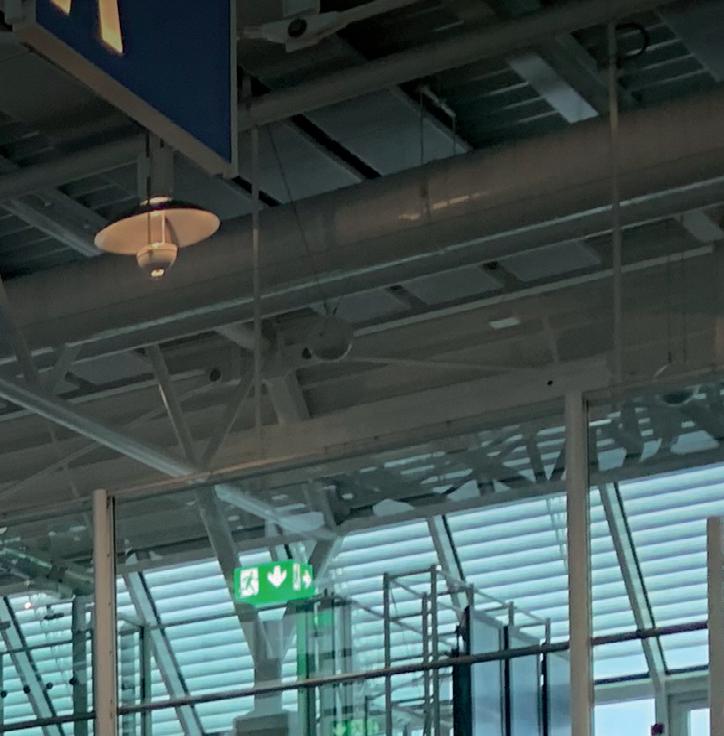



Different power and computing levels are an integral part of the digital display equation too. FIDS require minimal computing power, but high-end advertising graphics and control room systems are

2023 – 03 Airlines airlines.iata.org 31
“Airports are destinations in their own right. That means we are going beyond display screen provision for critical information, to creating digital experiences”
Sharp/NEC Display Solutions: Sponsored Feature
much more demanding. Sharp/NEC employs an integrated approach based on Intel®SDM-L or Raspberry Pi so an airport can choose the right computing power for the application.
New systems and increasingly large amounts of data will demand ever more powerful computing and Sharp/NEC, alongside its partners, is constantly evolving to keep pace. “We are not just providing our hardware,” says Hayes. “It’s more than that. We are part of a proven ecosystem where we have over 20 years of experience designing and engineering solutions for these environments.
“Our display hardware is engineered with an open modular intelligence design,” he adds. “Our clients enjoy the same reliability across any environment, benefiting from the most appropriate computing power for the application, and delivering an allimportant peace of mind.”
Purpose-designed for extreme operational demands, Sharp/NEC’s solutions are highly reliable. “We have screens in many airports that have been running for eight years and longer, surely there’s no better illustration of the quality of our products,” says Hayes. “This long lifecycle, plus the option to upgrade the computing power within, means our solutions are performing sustainably.”
Future challenges
Indeed, sustainability is always a top priority and must be integral to every aspect of business decision making. Sharp/ NEC has refined and optimised its manufacturing, packaging, and transportation processes for best efficiency. Sharp/NEC uses metal for the structural
components of its displays, which is 100% recyclable, contributing to the circular economy. Metal is also robust, heat resistant and fire retardant, making Sharp/NEC’s products safe for use in public spaces, a critical requirement for airport operators.
Hayes says one key development going forward is e-ink technology. This can be used for a static information display. The content is sent once and then the screen can display that information without the need for ongoing power until the content changes. This is useful for gate signage when the gate is not in use and will significantly reduce energy usage.
“It’s an interesting concept for the future,” says Hayes. “It won’t be appropriate for every situation, but it can save a lot of power consumption making it financially and environmentally sustainable.”
Digital display vendors must also address cybersecurity concerns. Airports are high-security facilities and every access point to operational systems must have cuttingedge security to protect any


vulnerabilities from attack, whether malicious or simply inappropriate. Should FIDS be disrupted, the confusion in the airport terminal can be extreme, something no operator wants to experience.
Another important concern is electromagnetic compatibility (EMC). Screens are getting larger. Sharp/NEC recently installed a 40m2 display for Swedavia and will soon double that for a different client. The electro-magnetism these screens emit cannot interfere with any operation-critical IT systems.
“The EMC has to be considered,” Hayes explains. “We are working hard in this area and are ahead of the curve.
“Aviation is a niche industry with many specific challenges and opportunities,” he continues. “There is the possibility of completely transforming the airport experience through dynamic digital display which offers boundless efficiencies. Of course, airports must strike the right balance. Sometimes less is more when you need the passenger to focus on making their flight.
“There will be plenty of innovation ahead which is where Sharp/NEC’s modular approach appeals—focusing on a lifecycle that can adapt with technology evolution.”
32 Airlines 2023 – 03 airlines.iata.org
“There will be plenty of innovation ahead which is where Sharp/NEC’s modular approach appeals— focusing on a lifecycle that can adapt with technology evolution”
Sponsored Feature: Sharp/NEC Display Solutions
Critical Installations
Demand Critical Performance
Safe for public spaces
Long-life sustainability
Optimised investment
Passenger satisfaction
In today’s airport environment, compliance with fire safety standards is critical. That’s why Sharp/NEC supplies display solutions that are proven fire-retardant, with a robust metal chassis and additional safety features.


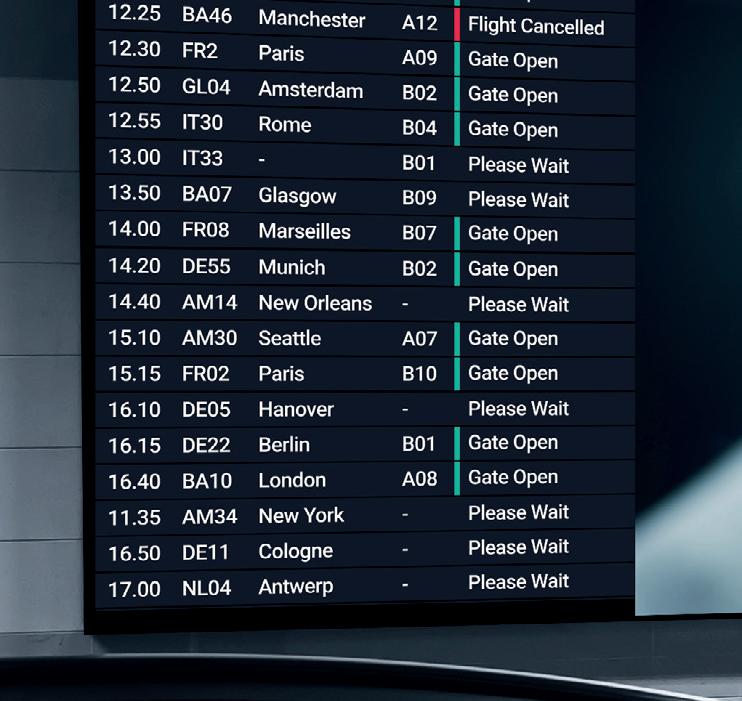




Delivering consistently outstanding performance and durability over a 10-year lifecycle with same-batch spare parts, our dvLED solutions are driving sustainable operations, reducing waste, and lowering costs.



Bright, high contrast and reflection-free surfaces present flight information, wayfinding, and advertising in vibrant clarity for distant and proximity viewing. Smoothing the way from check-in to baggage hall, dvLED solutions from Sharp/NEC create pleasurable experiences for the entire passenger journey.
Discover more at sharpnecdisplays.eu
dvLED
Last year our customers saved 80 tons of fuel per jet aircraft, using SITA OptiClimb®.







SITA OptiClimb® is the only solution to provide fully customized tail- and flight-specific recommendations, saving you up to 5% on climb-out fuel.
Now you know, what will you do? Find out more



www.sita.aero
Unruly passenger incidents on the rise
What rules and regulations can airlines use to reduce the rise in the disruptive behaviors of some passengers?
WORDS: GRAHAM NEWTON
Unruly passenger incidents increased in 2022 compared with 2021. There was one incident reported for every 568 flights in 2022, up from one per 835 flights in 2021.
The most common incident categorizations are non-compliance
Smoking
Failure to fasten seatbelts
Exceeding the carry-on baggage allowance or failing to store baggage when required
Consumption of own alcohol on board verbal abuse intoxication.
Thankfully, physical abuse incidents remain rare, but they did increase 61% over 2021, occurring once every 17,200 flights. This increasing aggression even includes threats to kill and must be stamped out.
35 airlines.iata.org Cabin safety 2023 – 03 Airlines
Regulations
The strategy to reduce unruly passenger incidents revolves around regulations and guidance, each of which has several elements.
It is important that governments and airlines have the necessary legal authority to prosecute unruly passengers, regardless of the state of aircraft registration, and a range of enforcement measures that reflect the severity of the incident. For this to happen jurisdictional gaps must be eradicated.
The most obvious solution is getting more countries to sign up to Montreal Protocol 14 (MP14), which gives states the necessary legal powers. By the end of June 2023, some 45 nations comprising 33% of international passenger traffic have ratified MP14.
“The ratification rate is accelerating and there is a strong pipeline with countries in an advanced stage toward ratification,” says Tim Colehan, IATA’s Assistant Director of External Affairs.
But ratifying MP14 and removing jurisdictional gaps is not a silver bullet. Enforcement action needs to be taken against those who disrupt flights.
Countries are responding within national regulations. France has extended the use of civil and administrative penalties to cover unruly incidents onboard flights, which are more effective against less serious infractions and other countries are considering replicating
them. The United States, meanwhile, has taken a zero-tolerance approach. If a crew member or other passenger is threatened or assaulted, then there will be action taken against the offender. In 2022, some $8.4 million in fines were issued with the most serious cases referred to the FBI to pursue criminal prosecutions.
“And the draft of the FAA Reauthorization Act proposed by the House of Representatives proposes new measures to deter interference with crew members,” says Colehan. “This includes a multi-stakeholder task force to develop voluntary standards and best practices on unruly passengers reporting to the Secretary of Transportation.”
Although many airlines maintain individual lists of banned unruly passengers, the concept of government-administered lists is more nuanced. This may be a completely justifiable and a useful deterrent, however it is likely that efforts in other areas will yield better results in the short term.
The main problem with bans is that data protection laws make it difficult for airlines to share information. And individual bans can be circumvented with name changes and new passports. China and India are among the countries that have national bans and government-controlled lists of unruly passengers in place, but a lot of work needs to be done.
“Bans can be an effective deterrent, especially where airlines can legally share that information,” says Colehan. “But there are challenges to improving the existing situation
61%
Physical abuse incidents increased 61% over 2021, occurring once every 17,200 flights
36 Airlines 2023 – 03 airlines.iata.org Cabin safety
“There is no excuse for unruly behavior. It is not just about respect for other passengers and the crew, it is about safety—always the industry’s top priority”
and, for the moment, focusing our efforts elsewhere will be more beneficial.”
Guidance
Preventing or de-escalating incidents is obviously the preferred option. Airports and civil authorities do take the unruly passenger problem seriously and there are examples of collaboration and awareness campaigns throughout the world.
In the United Kingdom, for example, the “One Too Many” campaign comprises duty free companies, police, restaurants, bars, and airports in a concerted communications effort. As part of this, World Duty Free puts alcohol in sealed bags adorned with messages advising customers not to open until they reach their destination.
“The Irish Aviation Authority has a similar declaration, and a lot is being done in Norway and other countries too,” says Jonathan Jasper, IATA’s Senior Manager for Cabin Safety. “It is encouraging that all stakeholders are collaborating to ensure that nobody is unnecessarily contributing to the unruly passenger problem.”
Sharing best practice on de-escalating incidents through manuals and training is equally vital. IATA issued a new guidance document at the beginning of 2022 containing advice for airline crews, as well as some practical solutions for governments on public awareness and fixing jurisdictional gaps.
Training, meanwhile, has taken on
increased importance following the disruption caused by the pandemic. “There are a lot of new crew that don’t have the experience or life skills to deal with some incidents,” says Jasper. “And even experienced crew missed a lot of flight time and then had mask mandates to handle. Training is constantly being re-evaluated to give all crew the best possible skills to deal with post-pandemic unruly passengers. This includes spotting behaviors before they escalate.”
There is also far better support for crew following incidents. Mental health and wellbeing are increasingly important, and Jasper says airlines are investing in this critical area.
“There is no excuse for unruly behavior,” says Jasper. “It is not just about respect for other passengers and the crew, it is about safety—always the industry’s top priority. The increasing trend of physical abuse is particularly worrying, and governments must enforce the law and penalize offenders. Passengers and crew are entitled to a safe and hassle-free experience on board.”
$8.4 m
In 2022, $8.4 million in fines were issued with the most serious cases referred to the FBI to pursue criminal prosecutions
37 2023 – 03 Airlines airlines.iata.org Cabin safety
The most obvious solution is getting more countries to sign up to Montreal Protocol 14 (MP14)
Sponsored Feature: Oman Airports
TOURISM DRIVES PASSENGER GROWTH FOR OMAN AIRPORTS
Tourist numbers to Oman continue to increase and with additional new air services, more hotel accommodation being brought to the market, and visa free access for visitors from over 100 countries, Oman continues to be a must-visit destination.
This is always an exciting time of the year for Oman Airports, as July and August are traditionally when we see high passenger volumes through our airports, and 2023 is definitely proving to be no exception to this trend.

In terms of visitor numbers to Oman, the winter months are often the busiest, however for the Dhofar region in the South of Oman, and the main city Salalah, July and August are also the peak tourism months. This time of year is Khareef season, which annually attracts visitors from across the Gulf, India, and also increasingly from Europe. Khareef season generally sees periods of rainfall across the South of Oman, and this, coupled with temperatures that are much cooler than the rest of the Middle East at this time of year, attracts more than half a million visitors during these months, enjoying the cooler climate, the green landscape, and of course the traditional Omani hospitality.
Salalah has seen an increasing number of airlines serving the airport to take advantage of the increasing visitors, and it has been encouraging to see the emergence of Europe as an important market. This season will see 10 European destinations
connected to Salalah, served by eight different carriers—with a particular focus on Central and Eastern Europe.
However, more recent expansion into Italy and Germany, particularly for winter breaks, has highlighted the importance of Western Europe as a target for more year-round travel, alongside the continued growth in existing markets. In fact, for 2023, passenger numbers from Europe to Salalah have already surpassed the full year in 2022, so this Khareef season and the rest of 2023 is looking to be as busy as ever.
This all demonstrates the potential of Salalah as a year-round tourism and visitor destination, and with an increasing number of European carriers operating, this will have a positive impact on the awareness

of Salalah, and Oman, as a beautiful must-see destination.

The European market has always been important for Oman, not only because of the high numbers of tourists traveling to the country, but also through the historically strong business and economic ties. Muscat is well connected to Europe, with 23 destinations served by ten scheduled and charter airlines, including the two home carriers. These airlines carried almost a million passengers in 2022—with a similar number already handled in 2023.
Visitor numbers to Oman reached nearly 3 million in 2022, as the world emerged from the pandemic travel restrictions, with this figure very close to the pre-COVID high. 2023 has already seen over 1.5 million visitors in the first five months of the year, and with the peak Khareef and winter seasons still to come, the expectation is for this year to far exceed 2022, and be a welcome return to pre-pandemic visitor levels.
Over the past 18 months, the easing of global travel restrictions has clearly been a key driver of growth. However, what has been a major help to support the return of
10
European destinations This season will see 10 European destinations connected to Salalah, served by eight different carriers—with a particular focus on Central and Eastern Europe
38 Airlines 2023 – 03 airlines.iata.org
visitors and boost tourism, has been the announcement by the Government that citizens of 103 countries can now avail themselves of visa-free entry to Oman for 14-day visits, with the potential to apply for an extension to their stay beyond this period.





The decision to waive visas underlines the importance of the tourism industry as one of the main drivers of the country’s economy. The tourism industry has always been important to Oman’s economy, and this is recognised through the projects that the Government is putting in place as part of their overall 20-year Vision 2040.
A range of tourism developments across the country are currently underway, with


1.7bn rials ($4.4bn) already being invested in projects out of a planned 3bn rials investment over the next 18 months; these developments are already making an impact through the increased visitor numbers.
One area in particular which is vital to supporting the tourism impact is the accommodation sector. The pandemic did not impact the ongoing development of hotel infrastructure in Oman. In fact, an additional 5,000 hotel rooms have been introduced to the market across the country since 2019, representing a 20% growth. Of this increase, almost 1,000 of these additional rooms are in the Dhofar region, with the focus on Salalah.
What is clear as we enter the second half of 2023, is that the tourism developments in Oman, the actions of the Government to simplify arrival, and the global appetite for travel, are all continuing to support growth. The additional hotel rooms and new infrastructure being brought to the market are ready to welcome the growing numbers of guests, and the team at Oman Airports are also looking forward to playing our part in providing a warm welcome and efficient service to all as they pass through our airports.
For more information about Oman Airports, please visit www.omanairports.co.om
39 2023 – 03 Airlines airlines.iata.org
“The European market has always been important for Oman, not only due to the high numbers of tourists, but also through the historically strong business and economic ties”
Oman Airports: Sponsored Feature
Noise mitigation
WORDS: GRAHAM NEWTON
As air travel returns postCOVID-19, communities are seeing aircraft movements increase. Moreover, a recent World Health Organization (WHO) report recommended noise limits and announced WHO research into possible links between noise and cardiovascular diseases. Both are raising awareness of noise issues.
Aviation has always taken noise mitigation seriously. To support industry efforts in this area, governments agreed on a clearly defined approach to be applied globally, known as the Balanced Approach. It was first adopted by the ICAO Assembly in 2001 and has been reaffirmed subsequently.
Four sequential principles guide the Balanced Approach:
A reduction of noise at source

Better land use and planning
Improved noise abatement operational procedures
Operational restrictions
Following these principles is of such importance that many countries have enshrined the Balanced Approach in law. When used appropriately, the Balanced Approach has a solid track record of helping local communities manage noise concerns while enabling the economic and social benefits of aviation.
Reducing noise at source—always the primary solution—has been going on for
Taking a Balanced Approach to aircraft noise
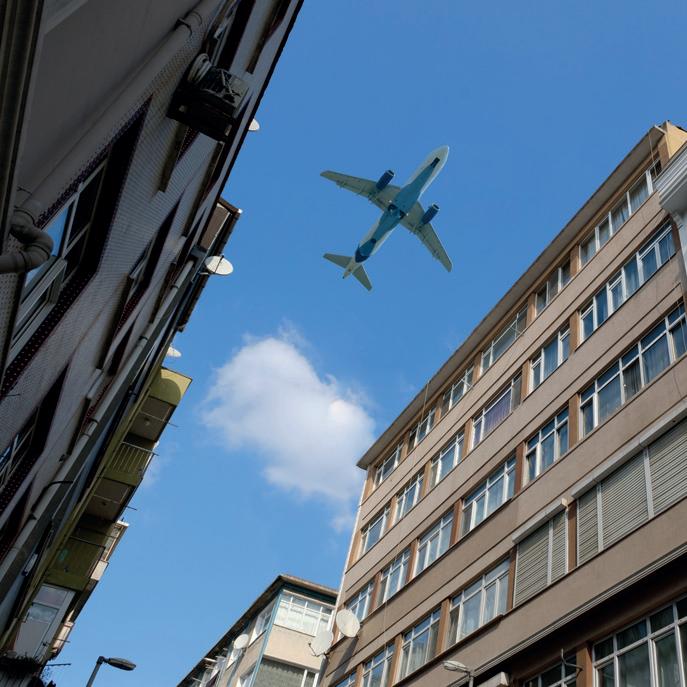
Though much of air transport’s sustainability efforts center on CO2 reduction, noise remains a significant challenge for the industry.
IMAGES: ISTOCK/ALAMY 40 Airlines 2023 – 03 airlines.iata.org
decades. Each generation of aircraft is on average 15% quieter than that of the generation they replace. Overall, manufacturers have achieved a 75% noise reduction in the past 30 years. And airlines have made noise management a key element of their fleet planning and sustainability strategies.
Land use and planning in airport areas is also crucial. It makes little sense to allow developments in areas sensitive to noise that could eventually put pressure on the operations of the airport. Unfortunately, this has happened multiple times. Had effective land use planning been properly followed since 2001, the extent of noise issues would be greatly reduced. Because many governments and airports have failed in land use planning, communities and businesses have encroached close to runways and flight paths.
Improved operational procedures, meanwhile, have been put in place at several hubs. New technologies, including performance-based navigation, which enables such developments as continuous climb and descent, will play an increasingly important role in reducing noise over nearby communities. Governments can help here by improving air traffic control, as the delays and disruptions in the European summer demonstrate. Holding patterns around major airports are familiar to every passenger.
Only as a last resort, after all other options have been exhausted, should operational restrictions be considered. Airports are major investments that create value for a community—both economically and socially—and it therefore makes sense to minimize noise while maximizing the benefits that air transport connectivity can bring.
“The Balanced Approach for noise management makes sense,” says Colette Zraibi, IATA’s Assistant Manager, Noise. “Using ever quieter aircraft, avoiding developments near airports, and managing flights to limit noise deliver real results





Noise mitigation



















Brussels Zaventem Airport
In July 2023, Belgian’s Federal Transport Minister, Georges Gilkinet, proposed banning night flights at Brussels from October 2024 and limiting noise at other times of the day. There was no consultation on other potential noise mitigation measures. If the Balanced Approach is followed it would not only support the Belgian economy but also maintain Belgium’s critical role in the global cargo network. The country is particularly strong in pharmaceutical exports which rely on air transport for rapid, time-andtemperature controlled shipment.
“The noise concerns of the community around Brussels airport must be heard, but it is profoundly unfortunate that Minister Gilkinet has attempted to circumvent the Balanced Approach, which is the long-accepted and successful international process for managing airport noise impacts,” says Rafael Schvartzman, IATA’s Regional Vice President for Europe.
“The Balanced Approach works. Communities benefit from noise management and economies get the maximum benefit from the airport infrastructure, not least in terms of thousands of jobs. It is vital that the government scrap this proposal and instead engage in a meaningful consultation with stakeholders.”

without compromising an airport’s operations. Like any global standard, the Balanced Approach delivers its best results when everyone follows the same rules.”
Collaborative efforts
There are many instances of the Balanced Approach being used effectively. Frankfurt Airport, for example, has implemented various active and passive noise abatement measures. The increased use of a westerly direction for flights avoids local communities and, between 23:00 and 05.00, a satellite-based approach procedure for improved trajectories.
In the United Kingdom, Stansted recently released its five-year draft Action Noise Plan for consultation. One of the aims is to have 94% of arriving aircraft perform a continuous descent approach, which can reduce arrival noise by up to five decibels. In Seattle, the Port Authority has worked with airlines to reduce
“When used appropriately, the Balanced Approach has a solid track record of helping local communities manage noise concerns while enabling the economic and social benefits of aviation”
41 2023 – 03 Airlines airlines.iata.org
nighttime flights from the third runway and promotes continuous taxi to take-off, while Lima has set up a noise monitoring program and heads a Technical Committee on Aircraft Noise Mitigation that follows the Balanced Approach.
There are many more examples that show collaborative efforts using the Balanced Approach can successfully reduce noise while maintaining and growing the socio-economic benefits of air connectivity. Despite this, recent decisions in some countries run counter to this proven methodology.
Support for the Balanced Approach
The standards set out in Annex 16 to the Chicago Convention, including those relating to the Balanced Approach, are mandatory to all member states unless they have formally filed a difference.
“Annex 16 includes noise management and sets out the details of the Balanced Approach,” explains Michael Gill, ICAO’s Director, Legal Affairs and External Relations Bureau. “Every three years, 193 states endorse the Balanced Approach through its inclusion in an ICAO Assembly Resolution on the Consolidated Statement of continuing ICAO policies and practices related to environmental protection. That Resolution was again adopted at the 41st session of the ICAO Assembly in October 2022. The intention behind the Standards and Recommended Practices (SARPs) in the Annexes to the Convention is to establish uniformity and this is a key concept for a global industry.”
In fact, Article 37 of the Chicago Convention calls for contracting States to implement international standards in a uniform manner to the “highest practicable degree.” If a country knowingly fails to follow an agreed standard, then they must notify ICAO. Although there is no enforcement mechanism, Gill stresses that the overriding principle is one of good faith, seeking to always ensure compliance with all Articles of and Annexes to the Convention.
Amsterdam Airport Schiphol
In 2022, the Dutch Government introduced an “experimental” regulation for an interim capacity reduction at Schiphol. A legal battle is ongoing, but the main point is that capacity cuts will come into force in the winter 2023/2024 pending completion of the longer-term Balanced Approach process. So the government has jumped to step four of the Balanced Approach and will review steps one to three at a later stage. The industry is calling for this muddled method to be rectified.

Willie Walsh, IATA’s Director General notes that “there are no established international processes for such a retrograde exercise. We continue to ask the Dutch Government to revert to the Balanced Approach.”
The Netherlands now has an interim government, and it is unclear what decisions it can make.
“Serious questions remain,” says Leslie MacIntosh, IATA’s Director, Legal Services. “Will the Balanced Approach process be carried out in accordance with the EU regulation and ICAO guidance material or have operating restrictions through capacity reduction been predetermined as the outcome? Will the government act in time for the summer 2024 season?
And what will happen to historic slots?”
Additionally, the Balanced Approach is enshrined in EU regulation 598/2014 and forms part of two key bilateral air services agreements. The European Union deal with the United States specifically mentions the Balanced Approach as does its counterpart with Canada. Transport Canada has commented on the Amsterdam situation, noting that it breaks the EU-Canada agreement.
“In theory, Canada and the United States could take action and ban European flights,” says IATA’s Zraibi. “In part, the Balanced Approach was designed to avoid such state disputes—such as happened over hush kits—and politicians have a duty to follow an agreed principle.”
Zraibi also notes that these individual actions are not limited in their impact to the countries concerned. The problems caused ripple out across the network. The nighttime cargo flights from Brussels will relocate to other airports or the cargo will take to the roads. In other words, it doesn’t solve the problem, it simply moves it on.
The decades-old experience of Japan’s Itami Osaka airport could still hold lessons for Brussels and Amsterdam. Noise complaints over many years led to the construction of Kansai International Airport and a plan to shut Itami—the ultimate operational restriction. Although this happened before the Balanced Approach was agreed, recognition of what would be lost with the closure of the airport saw the community support a decision to keep the airport open with the implementation of several noise mitigating measures. Itami remains one of Japan’s busiest airports even today.
“Applying the Balanced Approach appropriately would lead to the best results for everybody, including the affected communities in Brussels and Amsterdam,” concludes Zraibi. “Instead, we have politicians trying to take individual action without clear oversight. We are not tackling noise effectively, and we are unnecessarily restricting economic progress and job creation.”
42 Airlines 2023 – 03 airlines.iata.org
Noise mitigation
Keep passengers and crew safe using live turbulence data








-








- Improve onboard experience




- Keep fuel costs down through optimal


iata.org/turbulence-aware
















LEADERS
THEY’RE
92% asset availability cfmaeroengines.com LEAP turns heads in the boardroom. LEAP-powered aircraft are achieving the highest days flown ratio* for their thrust class. That means fewer spare aircraft and more flights, which helps profitability climb. Another reason to say LEAP. By example. *Compared to 83% for competition, per third-party data.
AREN’T BORN.
ENGINEERED.

































 P
P



























































 Anko van der Werff, CEO, SAS
Anko van der Werff, CEO, SAS































































































































